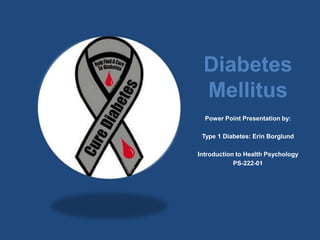
Type 1 Diabetes
- 1. Diabetes Mellitus Power Point Presentation by: Type 1 Diabetes: Erin Borglund Introduction to Health Psychology PS-222-01
- 2. What is Diabetes? Diabetes can occur when the pancreas does not produce enough or any insulin or does not use it properly causing elevated blood sugars Hyperglycemia Insulin: a hormone that helps to control blood sugar levels. Three types of diabetes: Type 1, Type 2, and Gestational.
- 3. Type 1 Diabetes Also known as Insulin-Dependent and Juvenile Onset Diabetes Diagnosis typically occurs in childhood or adolescence Autoimmune disorder: Insulin producing cells within the pancreas are attacked by the immune system causing high amounts of glucose in the blood. Accounts for between 5% and 10% of diagnosis'. Taking insulin (either by injection or pump) is a mandatory part of type 1 diabetes treatment.
- 4. Symptoms of Type 1 Diabetes Warning signs of type 1 diabetes may occur suddenly and include: Extreme thirst Frequent urination Drowsiness or lethargy Increased appetite Sudden weight loss Sudden vision changes Sugar in the urine Fruity odor on the breath Heavy or labored breathing Stupor or unconsciousness
- 5. Potential Psychological Effects of Type 1 Diabetes Depression Stress Low Self Esteem Preoccupation with Health-Related Thoughts Anxiety Social Anxiety Management techniques among adolescents were greatly influenced by psychosocial factors, including cognitive and interpersonal aspects.
- 7. Self Esteem and Type 1 Diabetes Studies show that females will refrain from inject insulin due to a fear of gaining weight. Illness becomes part of an individuals personal identity. Diagnosis of diabetes can lead to feeling different or not normal when compared to peers. Often try to redefine their identity. Cole et al. conducted a study that showed that young children believed diabetes was the fault of the individual. Younger children were also less likely to accept individuals with diabetes. Also, children perceived diabetes to be contagious. Not being accepted by peers can lead to low self esteem.
- 9. Emotional Support seems to have the greatest effect, in regards to adherence, when considering the adolescent population (Kyngas, 2004).
- 11. Social Support Continued School Teachers typically knew about the students illness, but continued to treat them in the same way as the other students. A level of comfort was achieved when assurance that the school nurse knew about the disease and how to handle them in emergencies. Classmates: Encouragement Teasing Negative Persuasion Technology Chat rooms, especially, allow for anonymous and nonjudgmental communication. Pets Comforted adolescents when they were sad or felt lonely.
- 12. Implications Revision of the Diabetes Management Health Care Team Include Psychologists or Counselors Education Programs Schools Hospitals It is important for everyone involved in a person with diabetes’ care to understand the individuals’ life circumstances and how diabetes fits into their lives.
- 13. References Battista, A. M., Hart, T. A., Greco, L., & Gloizer, J. (2009). Type 1 diabetes among adolescents: Reduced diabetes self-care caused by social fear and fear of hypoglycemia. The Diabetes Educator, 35(3), 465-475. Cole, K. L., Roberts, M.C., & McNeal, R. E. (1996). Children's perceptions of ill peers: Effects of disease, grade, and impact variables. Children’s Health Care, 25(2), 107-115. Dovey-Pierce, G., Doherty, Y., & May, C. (2007). The influence of diabetes upon adolescent and young adult development: A qualitative study. British Journal of Health Psychology, 12(1), 75-91. Kyngas, H. (2004). Support network of adolescents with chronic disease: Adolescents’ perspective. Nursing and Health Sciences, 6(4), 287-293. Sarafino, E.P. & Smith, T.W. (2011). Health Psychology: Biopsychosocial Interactions. Hoboken, New Jersey: John Wiley and Sons, Inc. Tercyak, K. P., Beville, K. W., Walker, L. R., Prahlad, S., Cogen, F. R., Sobel, D. O., & Streisand, R. (2005). Health attitudes, beliefs, and risk behaviors among adolescents and young adults with type 1 diabetes. Children’s Health Care, 34(3), 165-180.